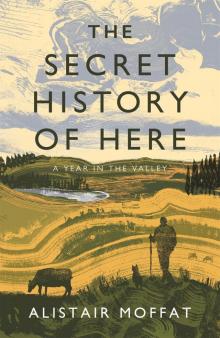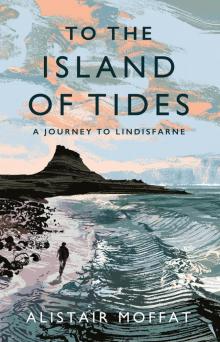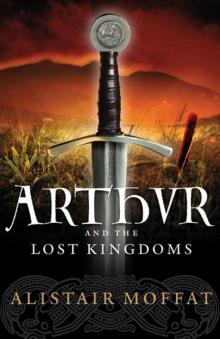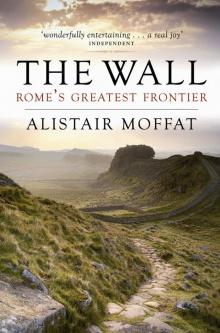- Home
- Alistair Moffat
The Wall Page 17
The Wall Read online
Page 17
Why? The reason given sounds like a polite euphemism, or a pretext. If the Praetorians and the Chancery had been plotting with the Empress, then surely heads would have rolled. Suetonius and Clarus certainly survived, as did the Empress Sabina. Perhaps they had simply become too powerful. Perhaps the frumentarii had heard what modern security services call chatter, and the Emperor acted quickly to forestall it developing into anything more. Dealing with the Praetorians in particular demanded delicacy. But this curious incident is clear in at least one respect: Hadrian could be ruthless, decisive and dangerous to know – just like most Roman emperors.
At the outset of his reign there was trouble. At Vindolanda, an inscription has been found which tells of war in Britain. Rebellion and war crackled in other provinces, and Trajan’s conquests appeared to overstretch resources. Perhaps the notion of limiting the Empire was bruited about early. To stop opposition and the threat of insurrection in their tracks, Hadrian took decisively brutal action. Four consulars, soldiers of the highest aristocratic standard who had held the consulship under Trajan, were murdered in the early months of the new regime. Avidius Nigrinus, Lusius Quietus, Cornelius Palma and Publilius Celsus may not have been guilty of treason – more likely they disagreed with the new policy of retrenchment – but Hadrian did not hesitate.
This early purge stained the new Emperor’s reputation profoundly, He was hated by the senatorial elite throughout his reign, and the resulting atmosphere may have been an important factor in Hadrian’s extended tour of all the provinces of the Empire. In eleven years he visited all thirty-six and must have been the most recognised Roman emperor in history.
Beyond the atmosphere of mistrust that swirled around Rome and also around his close political circle, Hadrian sometimes revealed a more relaxed, informal and even playful side. Annaeus Florus was a poet, teacher and historian who lived at the city of Tarraco (Tarragona) in Spain. Also having significant Spanish connections (he was born in the Iberian city of Italica and was said to speak Latin with a strong Spanish accent), the Emperor appears to have known the poet and while Hadrian was in Britain the two men exchanged a remarkable but, sadly, very brief correspondence. Here are Anthony Birley’s translations of two short poems, Florus’ first, with the missing third line improvised and added here:
I don’t want to be Caesar, please
Tramping around the British, weak at the knees
[Or lurking with the Germans amongst all those trees]
Or in the Scythian forests to freeze
The references seem to follow Hadrian’s first journey along the northern frontiers in reverse order. Scythia was his first destination and an ancient name for the area around the outfall of the Danube into the Black Sea. Then he travelled to Germany and the Rhine frontier, and finally to Britain. Fortunately for Florus, Hadrian was amused and sent back a witty reply:
I don’t want to be Florus, please,
To tramp around pubs, into bars to squeeze,
To lurk about eating pies and peas,
To get myself infested with fleas.
CASTEL SANT’ANGELO
Hadrian fancied himself as an architect, but when he attempted to offer an opinion at a meeting between Trajan and his chief architect, Apollodorus, the latter told him to mind his own business. It turned out to be an ill-advised remark, for when Hadrian at last became emperor, Apollodorus was banished and perhaps worse. Concerned that the imperial mausoleum built for Augustus was full, Hadrian commissioned a new one for himself and his successors. He is said to have had more than a hand in the design. As centuries passed and Rome declined, it looked increasingly as though the mausoleum stood on a vulnerable site, on the west bank of the Tiber, near what became the Vatican City. It was renamed Castel Sant’Angelo and became the principal stronghold of the Pope. All of its decorative sculpture was lost (some of it hurled at besieging barbarian armies by the Byzantine expeditionary force which had retaken Rome for the Empire in 537) and its basic drum shape (not unusual for a mausoleum but definitely so for a fortress) is all that remains to hint at its previous use.
In seeking to set examples, refusing to ask his men to do more than he would do himself, Hadrian bivouacked with his legions, eating simple fare, drinking rough wine around the campfire – and marching 20 miles in full armour the morning after. He was forty-one when he succeeded Trajan, and he enjoyed a deserved reputation for toughness. His eleven years of tramping around the provinces made him fit and hard-riding. Practice with the javelin and frequent hunting expeditions taught him weapons skills and kept him active on into his middle age. Like Alexander the Great, Hadrian had a favourite horse and he loved to ride in the chase with his beloved hounds. Game pie, stuffed with wild boar ham and the meat of game birds, was said to be a dish he ate with great relish. Hard physical exercise and discipline were everything, an ideal which all soldiers should cherish and constantly aspire to. In the waters of the North Tyne a walker came across a Roman altar dedicated to the Discipline of the Emperor.
A tall man with a trimmed beard and his hair curled by a comb, Hadrian was said to be an imposing figure. Unusually, his surviving portrait busts all look alike, a firm jaw and broad across the cheekbones. No delicate features, but a mature man of action, a soldier in his prime. Hadrian’s hero was Pericles, the bearded Athenian statesman of the fifth century BC. And as the first Roman emperor to wear a trimmed beard (the longer, straggly sort was thought more suitable for philosophers) in the same Greek style, there is a sense of admiring imitation.
And yet the Emperor was devoted to a beautiful Greek boy, Antinous, clearly the love of his life. More than a hundred representations of Antinous have come down to us, and it seems that he was indeed a very striking-looking young man. Hadrian may have met him in AD 123 when the imperial fleet sailed along the Black Sea coast of what is now Turkey. Pontus-Bithynia was the name of the Roman province, and its coastal cities had originated as Greek colonies. It was a very different place from Britain, where Hadrian had been the year before. Like most Roman aristocrats of the time, Hadrian spoke Greek well and indeed had been governor or Archon of Athens before becoming emperor. Perhaps Antinous embodied all that Hadrian admired in Hellenic culture. In any event, he was devoted to the boy and they almost certainly became lovers.
But there may have been a problem. An affair with a young boy was almost acceptable, even amongst the more starchy Roman aristocratic families. But an affair with a young man on the edge of puberty, perhaps sprouting a beard – that was something that caused much more uneasiness. To be the object of another man’s desire at that age, and to be penetrated by him, was shaming. But what could Antinous do? He had to obey the most powerful man in the known world, and also put up with all the vicious gossip and malice which slithered around the imperial court. It was an impossible position and several historians believe that Hadrian’s insistent devotion probably drove his lover to commit suicide. Matters seem to have come to a head when the imperial entourage reached Egypt.
When Antinous drowned in the Nile in 130, in mysterious circumstances, the world turned upside down. Hadrian’s grief was immense and some commentators reckoned the remainder of his reign was spent in slow and miserable decline. Perhaps some scant consolation was found when Antinous was declared a god.
Homosexuality in Greek and Roman times carried different connotations. Men who made love to other men were not seen as deviant but just as manly as those who did not, perhaps even more so. And the modern concepts of concealment and shame appeared not to apply at all. While many men seem to have been bisexual, Hadrian’s relationship with Antinous does contrast sharply with what is known about his marriage.
GAY ROMANS
There are no words in either Latin or Greek for homosexuality, and although sex between men (and between women) was often commented on, in itself it was not seen as a separate phenomenon or category. Society did not divide into gay and non-gay. Much more significant were sexual relations which crossed boundaries between social class, say, a
ristocrats and slaves. Modern attitudes do not apply to Roman and Greek homosexuality. There certainly was a distinction between active and passive, between ‘male’ and ‘female’ roles in homosexual relationships, but these generally followed pre-existing social or age-related hierarchies. The Romans called homosexuality ‘Greek love’ and that gloss may have attracted Hadrian Graeculus, the Little Greek.
Hadrian’s wife, Sabina, was well connected. The great-niece of Trajan and daughter of Matidia, a favourite of the Emperor, she made a good match for Hadrian. Some time around AD 100 they married. He was twenty-five and about to take his seat in the Senate, and she would have been considerably younger, probably fifteen. Like most aristocratic marriages, the function was political not passionate. What mattered was advantage and advancement, with the incidental possibility of producing children. Hadrian and Sabina failed in the latter, but succeeded in all else. Sadly their childless marriage seems to have withered into lovelessness, antipathy and even sustained anger. Hadrian was said to have grumbled that his position as emperor forced him to stay with Sabina. If he had been an ordinary citizen, he would have divorced her long ago on account of her moods and contrariness. Quotes from a now-lost biography of Hadrian by Marius Maximus asserted that Sabina had taken steps to avoid becoming pregnant by him – because his children would only do harm to the human race. It seems that she needed to consider contraception, and it may be that the bisexual emperor had at least attempted to do his dynastic duty.
By contrast, Hadrian’s relations with his mother-in-law, Matidia, were much warmer. Perhaps he was first encouraged by the fact that the childless Trajan treated Matidia like an adopted daughter. Or perhaps he felt more comfortable in the company of a mature woman, relaxing in a version of maternal love, a relationship without the embarrassment of sexual expectations or obligations. Trajan’s Empress, Plotina, was also close to Hadrian, and ultimately she took a leading role in persuading her dying husband to adopt her protégé formally in 117. At the risk of reading too much into a scatter of sparse snippets of evidence, it may be that Hadrian’s homosexuality played in his favour as he cultivated these older aristocratic ladies.
In the fort at Newcastle, Sabina and her entourage no doubt made themselves as comfortable as was possible in trying circumstances. When the VI Legion sailed up the Tyne in 120 to reinforce the garrison of Britannia, their commanders caused two altars to be raised in thanksgiving for a safe crossing of the North Sea. Oceanus controlled the tides of the sea, and Neptune was seen at that time as a river-god. Perhaps the Empress Sabina and the ladies of the court made sacrifice on these altars. She may have known then that this chilly, northern outpost was by no means the last destination on her husband’s itinerary. A great deal of travel lay in store.
Meanwhile it was decided to try the favour of Neptune a little more by building a bridge across the Gateshead Gorge. Placed close to where the modern Swing Bridge is, the bridge was a tremendous undertaking but logistically well worth the effort. If the Emperor was considering a permanent frontier north of the river then it was vital to be able to cross the Tyne quickly.
Wooden piles were driven into the muddy river-bed as engineers struggled to establish footings for the piers of a stone bridge but, interested though he was in architecture, it is unlikely that Hadrian hung around to watch. Guarded by the Praetorians and protected by a screen of scouts sweeping the countryside in front of them, he and Platorius Nepos probably rode west to look at the line of the proposed frontier. Only then would the scale of the work have become clear, the practicalities of construction, and the deployment of the legions and their camps. As he rode up into the moorland above the Hexham Gap, the idea of a wall, a stone girdle built across the waist of Britain, had formed in Hadrian’s mind.
6
Let One Stone Stand Upon Another
In 1933 Patrick Leigh Fermor disembarked at the Hook of Holland to begin an epic journey. At the age of eighteen, expelled from school, with only a pound a week to live on, he had decided to walk across Europe. Many years later, he wrote down what he had seen, an extended glimpse of a now-vanished Europe, in two volumes of a promised trilogy, A Time of Gifts and Between the Woods and the Water. Following first the Rhine and then the Danube, he kept a diary (later lost) of his travels, and it ends at the Iron Gates, a sequence of spectacular river-gorges. Between the Carpathian Mountains on one side and the Balkans on the other, the Danube races and swirls, its currents deep, treacherous and violent. As Leigh Fermor passed through on board a steamer, he noticed a Latin inscription incised directly into one of the towering cliffs.
The Emperor and Caesar, son of the divine Nerva, Nerva Trajanus Augustus Germanicus, High Priest and for the fourth time Tribune, Father of his Country and Consul for the fourth time, cutting into the mountains and on wooden beams, raised up this road.
When the skipper expertly steered his boat around the whirlpools and underwater rocks, he sometimes sailed very close to the sheer rock face. Leaning over the rail, Leigh Fermor could see something remarkable. No more than a few metres above the boiling river a continuous slot had been quarried, hacked directly out of the cliffs. Two and a half metres high and three metres deep, it was large enough to allow men to walk two abreast. But it was not, as Leigh Fermor believed, a Roman road. In AD 102 Trajan planned to lead a huge army to invade and subdue Dacia, much of modern Romania, and he wanted his soldiers to be supplied by river. Because the currents of the Danube were so powerful as it sped through the Iron Gates, barges would need to be towed upriver. A wooden platform wedged into the slot (replacing an earlier and more fragile structure first built under the Emperor Domitian) would not carry marching legionaries but probably teams of men hauling on hawsers, dragging the barges through the gorge.
Further downstream, at the Great Kazan, where the current is calmer and the channel widens, Trajan ordered a bridge to be built across the Danube. Designed by the Greek architect Apollodorus, it was to become one of the wonders of the ancient world. It reached more than a kilometre in length, was 15 metres wide and raised on twenty stone piers. Completed in AD 105, it was the longest bridge in the world, and would remain so for another thousand years.
Apollodorus faced tremendous structural problems. Thirty metres deep in places and liable to seasonal spates of great ferocity, the Danube could be unrelenting, washing away months of work in moments. But using coffer dams and huge water pumps, and building in bricks, mortar and pozzolana cement (which hardens when in contact with water), all twenty piers were finally sunk and the current diverted around them by sharply pointed cutwaters. A wooden superstructure was prefabricated on shore and lifted into place. And in the spring of 105 Trajan led the legions across, crushed the Dacian army and brought their lands into the Empire.
When his steamer arrived at the same place, here is what Patrick Leigh Fermor saw:
It was the remains of Trajan’s amazing bridge that we had come to see, the greatest in the Roman Empire. Apollodorus of Damascus, who built it, was a Greek from Syria, and two great stumps of his conglomerate masonry still cumbered the Rumanian side; a third stood across the water in a Serbian meadow. Swifts were skimming over the water and red-legged falcons hovered and dived all around these solitary survivors of twenty massive piers. Once they had risen tapering to a great height and supported over a mile of arched timber superstructure: beams over which cavalry had clattered and ox-carts creaked as the Thirteenth tramped north to besiege Decebalus in Sarmizegethusa. On the spot, only these stumps remained, but the scene of the dedication is carved in great detail on Trajan’s Column in Rome, and the Forum pigeons, ascending the shaft in a spiral, can gaze at these very piers in high relief: the balustered bridge soars intact and the cloaked general himself waits beside the sacrificial bull and the flaming altar with his legionaries drawn up helmet-in-hand under their eagle standards.
As Leigh Fermor saw, only the abutments at either end of the great bridge are still visible, but in a year of exceptional drought and low water (18
56), all twenty piers were revealed. Trajan’s bridge and towpath were extraordinary structures, two of the greatest feats of engineering undertaken in Europe before the 19th century. Emblematic of the age, the zenith of the Roman Empire, they set Hadrian’s Wall in a clear context. Emperors saw themselves as the Lords of the Earth, not hesitating to alter or overcome geography in pursuit of glory, in the drive for empire.
LUPERCALE
The legend of Rome’s origin centres around the unlikely story of a she-wolf coming to the rescue of the twins Romulus and Remus. Abandoned on the banks of the Tiber, they were taken by the wolf to her cave and she suckled them and saved their lives. No wolf, no Rome. The rest was history (rather than legend). Known as the Lupercale, the cave and the rescue were thought to be little more than myth. But, in November 2007, Italian archaeologists held a press conference. Excavating on the Palatine Hill on the site of the Emperor Augustus’ palace, they had found a cave, a cave which had been a shrine. It was decorated with mosaics, sea-shells, pumice stones and had a representation of a white eagle at its centre. Was this the Lupercale, the sacred place where the wolf had suckled Romulus and Remus? It appears that Augustus, who understood well the power of symbols, had attached himself securely, in architectural terms at least, to the history and destiny of Rome. Professor Giorgio Croci led the excavation, and became very excited: ‘You can imagine our amazement, we almost screamed.’ The Minister of Culture, Francesco Rutelli, was calmer: ‘This could reasonably be the place bearing witness to the myth of Rome, one of the most well known in the world.’ In March 2008 tourists were at last admitted to Augustus’ private apartments. Small and modest, they were decorated with standard frescoes for a man of his status and offer no clues as to his nature.

 The Secret History of Here
The Secret History of Here The Night Before Morning
The Night Before Morning To the Island of Tides
To the Island of Tides Arthur and the Lost Kingdoms
Arthur and the Lost Kingdoms Britain’s Last Frontier
Britain’s Last Frontier The Faded Map: The Lost Kingdoms of Scotland
The Faded Map: The Lost Kingdoms of Scotland The Wall
The Wall